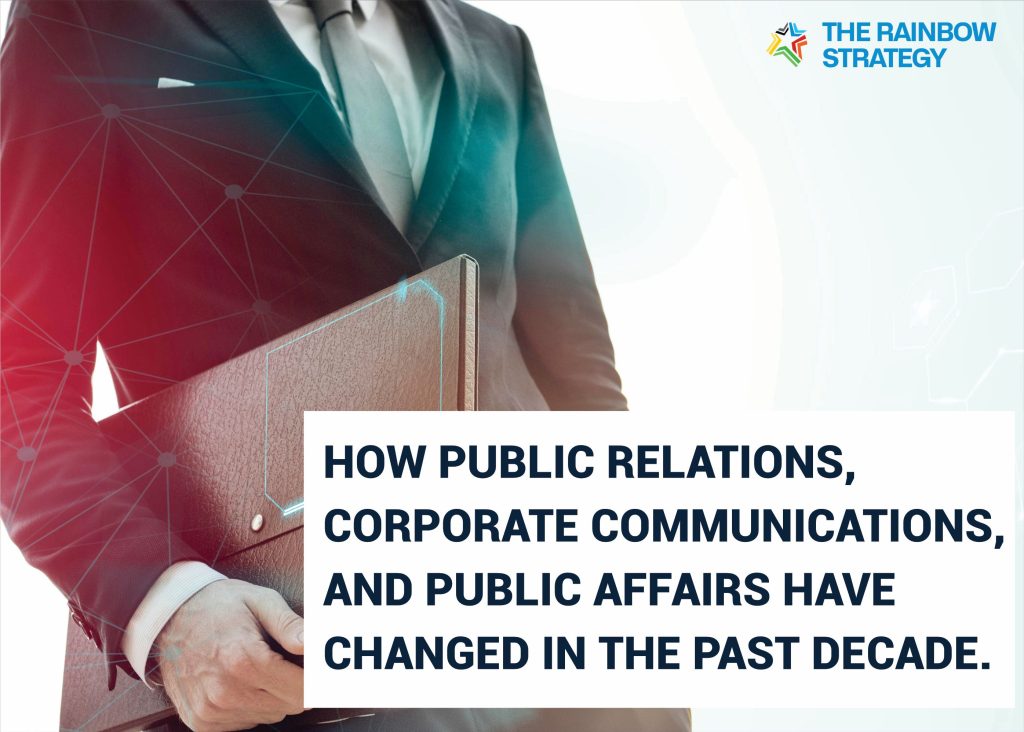The past decade has witnessed a seismic shift in the landscape of Public Relations (PR), Corporate Communications, and Public Affairs (PA). Driven by rapid technological advancements, shifting stakeholder expectations, evolving regulatory frameworks, and the rise of social movements, these fields have undergone profound changes. Understanding these transformations is crucial for professionals aiming to stay ahead of the curve and leverage new opportunities for impact.
- The Digital Revolution and Real-Time Communications
The digital revolution has redefined the way organisations communicate with their stakeholders. The traditional media landscape, once dominated by print, television, and radio, has expanded exponentially with the proliferation of digital channels, including social media, podcasts, webinars, and blogs. Today, information travels at lightning speed, and stakeholders expect instant responses. As a result, the “24/7 news cycle” has become the norm, necessitating agility in public relations, corporate communications, and public affairs strategies.
Implications:
- The rise of social media platforms like Twitter, LinkedIn, and Instagram has made real-time engagement and crisis management an integral part of PR strategy.
- Corporate communications must balance between maintaining a consistent brand narrative and responding to the rapidly changing digital discourse.
- Public affairs strategies have shifted from traditional lobbying to digital advocacy, where influencing public opinion through online platforms is key.
- The Power Shift: From Brands to Stakeholders
Over the past decade, there has been a significant shift in power dynamics from brands to stakeholders. Consumers, employees, investors, and the general public have greater access to information and are more vocal about their expectations. This shift has led to the rise of “stakeholder capitalism,” where companies are increasingly held accountable not just for their financial performance but for their social, environmental, and governance practices.
Implications:
- PR and corporate communication strategies now prioritize transparency, authenticity, and engagement over traditional top-down messaging.
- Public affairs professionals must navigate complex stakeholder landscapes, aligning their advocacy efforts with the interests and values of diverse groups.
- The rise of activism and social movements, such as #MeToo, #BlackLivesMatter and #EndSars, has pressured organizations to take definitive stances on societal issues, often at the risk of alienating segments of their audience.
- The Evolution of Crisis Management
The past decade has shown that crises can emerge from anywhere—data breaches, executive misconduct, environmental disasters, and social media backlashes. In this context, crisis management has evolved from a reactive practice to a proactive discipline. The impact of a crisis today can be amplified through digital platforms, making it imperative for organizations to act swiftly and decisively.
Implications:
- PR teams are now essential players in risk assessment and mitigation, requiring robust crisis communication plans that account for multiple scenarios.
- The role of corporate communications has expanded to include real-time monitoring and rapid response strategies to manage reputational risk.
- Public affairs efforts are increasingly focused on pre-crisis stakeholder engagement and relationship-building to create a buffer of goodwill in times of crisis.
- The Rise of Data-Driven Communications
Data analytics and artificial intelligence (AI) have revolutionized PR, corporate communications, and public affairs by providing unprecedented insights into stakeholder behaviour, sentiment, and preferences. This shift towards data-driven decision-making has enabled more targeted and effective communication strategies.
Implications:
- PR professionals now leverage data to measure the impact of campaigns, refine messaging, and predict potential crises before they arise.
- Corporate communications strategies are becoming more personalized, using data to tailor messages that resonate with specific stakeholder segments.
- Public affairs strategies benefit from data analytics by identifying key influencers, understanding policy trends, and crafting more compelling advocacy campaigns.
- Integrated Communications and the Convergence of Disciplines
The silos between PR, corporate communications, and public affairs have blurred, leading to a more integrated approach to communication strategy. Organizations now recognize the need for a unified voice that aligns PR, marketing, internal communications, and government relations.
Implications:
- The convergence has led to the emergence of “integrated communications” departments that manage both the brand narrative and stakeholder engagement across channels.
- PR and corporate communications professionals need to understand public policy, while public affairs specialists are required to grasp branding and media relations.
- The shift has driven the adoption of comprehensive narrative strategies that go beyond individual campaigns, focusing on building long-term reputational capital.
- Ethics, Trust, and the Demand for Authenticity
Trust has become a key currency in the digital age, where misinformation and “fake news” are rampant. In response, PR, corporate communications, and public affairs professionals have increasingly focused on building and maintaining trust with stakeholders through authentic and ethical communication.
Implications:
- Organizations are under more scrutiny than ever before, requiring a commitment to ethical practices and transparent communication.
- Authentic storytelling is now a cornerstone of corporate communication, emphasizing purpose-driven narratives that reflect a company’s values and culture.
- Public affairs efforts must be rooted in credibility, avoiding spin and focusing on factual, honest advocacy to maintain trust among policymakers and the public.
- The Role of Technology and Innovation
Technological advancements have reshaped the tools and tactics available to communication professionals. Virtual reality (VR), augmented reality (AR), artificial intelligence (AI), and chatbots have created new opportunities for immersive storytelling and personalized engagement.
Implications:
- PR strategies now incorporate innovative technologies to create interactive experiences and engage audiences in new ways.
- Corporate communications leverage AI-driven tools to automate routine tasks, enabling teams to focus on strategic, creative work.
- Public affairs professionals use digital tools to amplify their advocacy efforts, leveraging geotargeting, programmatic advertising, and online petitions to influence public opinion and policy.
Conclusion: Adapting to the Future of Communications

The past decade has transformed Public Relations, Corporate Communications, and Public Affairs into more dynamic, data-driven, and integrated disciplines. The future will likely see even more convergence of these fields, with a continued emphasis on transparency, trust, and technology. Professionals in these areas must be adaptable, proactive, and prepared to navigate the complex, fast-evolving communications landscape to maintain relevance and effectiveness.
To succeed in this new era, organizations must not only embrace change but also anticipate it, continuously innovating their strategies to meet the evolving needs and expectations of their stakeholders. The next decade promises even more transformation, and those prepared to adapt will lead the way.








